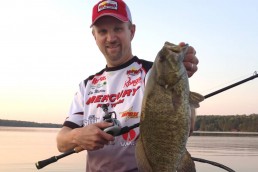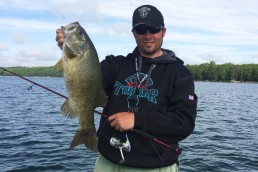‘Humping’ Summer for Nighttime Bass
SHARE THIS POST
It’s July, and daytime air temperatures are in the high 90s in Tennessee with the water temperatures not much lower. We can’t do anything about it, but we can fish during more comfortable hours. Fishing by the light of the moon or by artificial light at night affords us a measure of relief.
I’ve heard it said that bass aren’t as active in the summer as they are in spring and fall. That seems true if you’re looking for surface activity. The bass are actually more active June through September than any other period of the year. Their metabolism is higher and they require more food to maintain their health now. And these bass are eating out of sight, below the surface, which is why they seem to be less active.
Locating bass at night is fairly easy—just find some humps. With quality GPS that includes lake maps or the old-fashioned topographic map of your lake and a depth finder, you can then find the bottom features that hold bass more. Sonar units like my Humminbird has a slot for a chip, and that one chip alone includes many lakes and rivers. These maps are terrific tools for anglers, and from their website you can select the area you’re fishing and purchase the chip that covers that specific area. I’ve watched guides and other anglers use the electronic topo maps to great advantage.
Anatomy of a bassy hump
Humps, my favorite summertime structure, are unconnected points. The larger ones are similar to submerged islands. They may be associated with points at creek junctions or other bottom features. Humps vary in size, shape and depth, but it’s important to locate the ones closest to deep water. The biggest bass prefer the largest humps with tops less than 10 feet from the surface. The most productive humps are the ones on an otherwise featureless flat next to a river or creek channel.
To make a hump even more appealing, place brush piles on it. Bass seem to prefer logs and brush, which support the food chain leading up to the baitfish. Some bass experts say that bass prefer structures with a large surface area because there’s more food available in one area. A hump’s sides and top are accessible to the food chain and predators.
Anglers at night
“Most of the lakes I fish are hill-land and highland reservoirs,” says Tom Waynick, an angler from Normandy, Tenn. “They have more humps than flatland reservoirs.”
He says the Carolina rig works best for him on the humps.
“I Texas-rig a pumpkinseed, watermelon or green pumpkinseed lizard on a 5/0 hook. I always dip the tail in chartreuse dye. I don’t know why, but that extra color on the lizard makes it more effective or, maybe, it gives me more confidence.”
Tom’s uses 1/2- or 3/4-ounce egg sinkers on calm nights.
“I don’t measure the leader; I just pull off about this much,” he says, pulling the end of his line and stripping a section off his reel. “That’s about 3 feet—close enough.”
His 10-pound-test leader is tied to a barrel swivel attached to 15-pound-test line on a rod of his choice.
“I’ve found the 7-foot rod provides the backbone and long sweep I need for setting the hook.”
Tom makes his cast to the hump when his boat is in about 25 to 30 feet of water.
“When the weight hits bottom, I begin a slow, steady crank. If it stops, I continue to crank slowly. If it’s hung, in about three or four cranks, it will pop loose. If it doesn’t come loose I set the hook. Most times I don’t feel the fish; the line gets heavy, like reeling in a wet towel. I keep cranking until the tip loads up, and then I promptly sweep the rod to the side.”
Are you enjoying this post?
You can be among the first to get the latest info on where to go, what to use and how to use it!
John Smith
John Smith has Tims Ford Lake for a backyard and he fishes spinnerbaits on other bottom features.
“I use a 1/2- to 3/8-ounce bait with a single number 5, silver Colorado blade. I rely on its flash and vibration to pull fish off the points and bluffs where the water 4 feet off the bank is about 10 feet deep.”
John casts parallel to the bank and works the spinnerbait from 7 to 10 feet in depth. He also switches to a 4-inch craw-worm to cover the water column from 15 to 30 feet.
“The surface temperature can be 92 degrees, and it’ll be in the upper 80s at 15 feet. After 17 feet, the temperature drops into the 70s and stays in that range until you get down to 24 feet in an average summer season. After you get to 30 feet, the oxygen level goes down and the temperature is pretty stable. It’ll only change 1 degree every 5 feet.”
He says a black light is a necessity.
“The clear, blue fluorescent line is best at night. I use 12-pound test for spinnerbaits and 10-pound test for worm fishing.”
Roy Yates
“If the night is dark, I use a dark-colored worm,” says Roy Yates, of Chapel Hill, Tenn. “If there’s a moon I use a white and red worm.”
Roy is another nocturnal hump angler. He has a tackle box of nothing but worms, most of them are 6 inches long.
“Ten-pound test is as light a line as I use because I fish the rough stuff.”
His favorite humps he says are rocks along the main channel in the mid-section of Percy Priest Lake.
The night I fished with Roy he located the ends of an oblong hump with his depth finder and tossed out marker buoys.
Next, he positioned us on the shallow side of the hump, which ran parallel to the channel. We cast to bass on top of the hump. Then he moved the boat on top of the hump to fish the deep water by working the worms up the rocky slope. The deep-water side and ends of the hump held the most fish.
Bottom line
The places bass are at night are varied, and abundant. Besides the bottom features mentioned above, try fishing around bridge pilings, docks and boathouses, flats above the main channel, around islands, roadbeds and ledges.
Remember to fish “legally” at night. You must have your running lights and stern light on if you’re moving with the aid of a motor.
MWO
SHARE THIS POST
Did you enjoy this post?
You can be among the first to get the latest info on where to go, what to use and how to use it!
Vernon Summerlin
For more than 30 years, Vernon Summerlin has produced outdoor articles and books that can be found on Amazon; most recently How to Analyze a Bass Hole: Think and Catch’em! He is the recipient of more than 40 awards for magazine and newspaper articles, TV, radio, photography and books.




